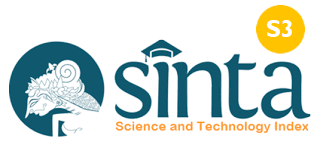Penerapan Model Pembelajaran Kooperatif Tipe Jigsaw IV Berbantuan Self Test Untuk Meningkatkan Aktivitas Dan Hasil Belajar IPA
Abstract
This research was aimed to improve the learning activity and the students` achievement of science in the class IX-J SMPN 1 Abang in the odd semester in 2017/2018 through the implementation of the jigsaw IV cooperative learning methiode assisted self test. The hypothesis of action in this research are: (1) The implementation of jigsaw IV cooperative learning method assisted self test, can improve the achievement of students of IX-J in science in SMPN 1 Abang in the odd semester in 20017/2018. (2) The implementation of jigsaw IV cooperative learning method assisted by self test, can improve the learning activity of students of IX-J in science in SMPN 1 Abang in the odd semester in 20017/2018. This research employed classroom action research was coucted in SMPN 1 Abang. The subjects of this research were the students of IXJ in the odd semester in 2017/2018. They were 33 students with consist of 17 boys and 16 girls. This was ddesigned in three cycles of PTK Kemmis and McTaggart models. The findings shows that (1) The implementation of jigsaw IV cooperative learning method assisted by self test can improve the achiemvement of the students of IX-J SMPN 1 Abang in the odd semester in 20017/2018. (2) The implementation of jigsaw IV cooperative learning method assisted by self test can improve the leatrninga ctivity of the students of IX-J SMPN 1 Abang in the odd semester in 20017/2018.
References
Badan Standar Nasional Pendidikan. 2007. Peraturan Menteri Pendidikan Nasional Republik Indonesia Nomor 41 Tahun 2007 Tentang Standar Proses untuk Satuan Pendidikan Dasar dan Menengah. Jakarta: Badan Standar Nasional Pendidikan.
Hamid Darmadi. 2012. Aktivitas Belajar Siswa Ala Paul B. Diedrich. Tersedia pada hamiddarmadi.blogspot.com. Diunduh Tanggal 11 Maret 2018 24.00 wita.
Holliday, Dwight C. 2000. The Development of Jigsaw IV in a Secondary Social Studies.Classroom. U.S.Of Educational Research and Improvement Educational Resources Information Center (ERIC). Indiana University Northwest
_______. 2002. Jigsaw IV: Using Student/Teacher Concerns To Improve Jigsaw III. U.S.Of Educational Research and Improvement Educational Resources Information Center (ERIC). Indiana University Northwest
Jansoon, Ninna. At al. 2008. Thai Undergraduate Chemistry Practical Learning Experiences Using the Jigsaw IV Method. Journal of Science and Mathematics Education in Southeast Asia 2008, Vol. 31 No 2, 178-200. Institute for Innovation and Development of Learning Process Mahidol University, Thailand
Nasution S. 2000. Berbagai Pendekatan dalam Proses Belajar dan Mengajar. Jakarta: Bumi Aksara.
Slavin, R E. 1995. Cooperative learning 2ed. Needham Heights, Masaachuetts: Allyn and Bacon.
Sudarsana, I. K. (2018). Optimalisasi Penggunaan Teknologi Dalam Implementasi Kurikulum Di Sekolah (Persepektif Teori Konstruktivisme). Cetta: Jurnal Ilmu Pendidikan, 1(1), 8-15.
Timayi, J.M. at al. 2015. Effects of Jigsaw IV Cooperative Learning Strategy (J4CLS) on Academic Performance of Secondary School Students in Geometry. International Journal of Mathematics Trends and Technology- Volume 28 Number 1 – December 2015, page 12-18. ISSN: 2231-5373. Department of Science Education, Ahmadu Bello University, Zaria, Kaduna State, Nigeria.
Turkmen, H. & Buyukaltay, D. 2015. Which one is better? Jigsaw II versus Jigsaw IV on the subject of the building blocks of matter and atom. Journal of Education in Science, Environment and Health (JESEH), 1(2), 88-94, ISSN: 2149-214X. Ege University
Downloads
Published
How to Cite
Issue
Section
License
An author who publishes in the Cetta : Jurnal Ilmu Pendidikan agrees to the following terms:
- Author retains the copyright and grants the journal the right of first publication of the work simultaneously licensed under the Creative Commons Attribution-ShareAlike 4.0 License that allows others to share the work with an acknowledgement of the work's authorship and initial publication in this journal
- Author is able to enter into separate, additional contractual arrangements for the non-exclusive distribution of the journal's published version of the work (e.g., post it to an institutional repository or publish it in a book) with the acknowledgement of its initial publication in this journal.
- Author is permitted and encouraged to post his/her work online (e.g., in institutional repositories or on their website) prior to and during the submission process, as it can lead to productive exchanges, as well as earlier and greater citation of the published work (See The Effect of Open Access).
Read more about the Creative Commons Attribution-ShareAlike 4.0 Licence here: https://creativecommons.org/licenses/by-sa/4.0/.





